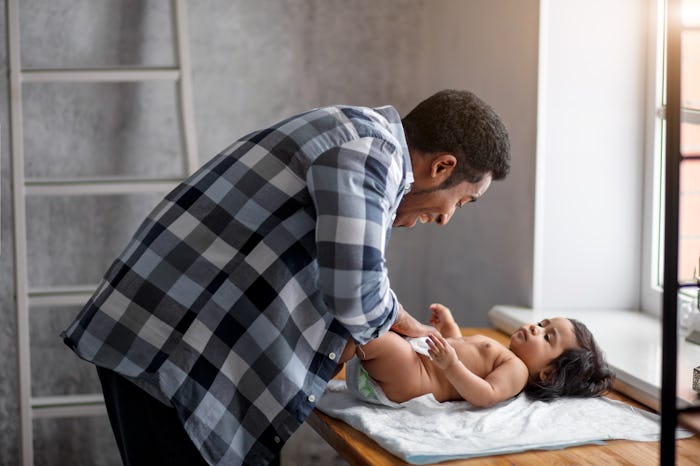Life

Here's How Breast Milk May Be The Secret Weapon To Healing Your Baby's Diaper Rash
Breast milk is pretty amazing stuff — it boosts a newborn’s immune system, can lessen the risk of SIDS, and even changes based on a baby’s needs. But is it true that breast milk can help heal diaper rash? Research has found that breast milk actually can be an effective treatment when applied topically, likely due to its antibacterial properties.
DrJaimeFriedman.com, a pediatrician-authored website, suggested that newborns will make eight to 10 wet diapers per day, and breastfed babies tend to poop with every feeding. This all adds up to some pretty strong chances of diaper rash for your little one at some point. So, if you’re a breastfeeding mama with some spare milk in the refrigerator, it’d be nice to use something you already have on hand to heal your baby’s diaper rash as quickly as possible.
Cathy La Torre, IBCLC, DNH, founder of Holactic Health, tells Romper in an interview that the most important thing is to use a diaper rash treatment that works for you and your baby. “I think there are so many creams on the market that there’s already so much to try out there. In our research, nothing is the best. Everyone has their own thing. I recommend whatever is the most compatible for you,” she says. “The components of breast milk are all in favor of treating any kind of fungal infection or soreness. It’s got antibodies in it, and healthy fat to help protect skin. With diaper rash it’s very sore for the baby, so it will still need some protection, such as an ointment. With diaper rash, I know A&D is beautiful and I always had that one on hand. It just gives that protection on top of the soreness until it goes away.”
When it comes to applying diaper rash cream, the consistency of a lotion or ointment makes the process pretty easy. But what’s the best way to apply a liquid treatment, like breast milk? La Torre suggests being hands off with this.
“I would love to see a mom try spraying the breast milk on the buttocks after cleaning them really well, maybe with a warm, soft washcloth,” she says. “Make sure baby is really clean before you start putting stuff on. Breast milk can be left out for a while, so it can be left on the table for a bit between tries. I think, during the diaper rash bout, you could set some aside in the spray bottle and keep it in the refrigerator, and when it’s not too hot in the house, it can sit at room temperature for four to six hours. It can be left in the fridge for three to eight days. It may even feel nice on the baby’s skin if it is a bit chilly."
La Torre also says she loves hand fans for drying your baby's skin, and making sure there's no moisture between their buttocks and you’re not setting up any infection.
But if you’re not sure about using milk applied directly to the rash, many women online have given their babies breast milk baths to help soothe diaper rash. MotherRisingBirth.com noted that breast milk baths can help heal the rash, moisturize skin, and take down any other irritation, too.
“Some moms do breast milk baths, and adding it to their bath would be a good thing for their rash, I would think," adds La Torre.
For moms who aren’t breastfeeding but looking for a more natural diaper rash treatment than OTC ointments, there are other options out there. “Some moms love coconut oil; some moms want to move on to creams. I always recommend it and give out samples because it’s antifungal and antibacterial. With diaper rash, I would say try and see how baby does with it. It’s very much like breast milk in that way.”
Expert:
Cathy La Torre, IBCLC, DNH, founder of Holactic Health
This article was originally published on